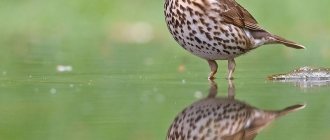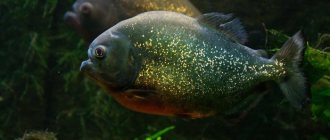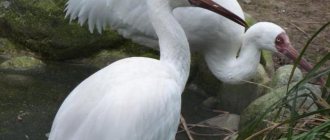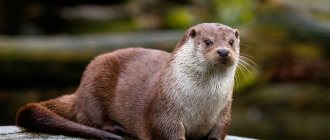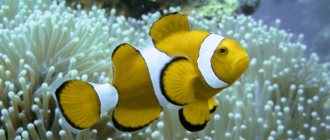Appearance
Osprey is a fairly large bird, with a body size ranging from 55 to 58 centimeters in length and a wingspan of around 150 centimeters. The head color is white with a characteristic black stripe that starts from the beak and ends at the back of the head. The upper part of the body is black and gray. On the chest is a necklace of black feathers. There is a small crest in the back of the head. The feathers themselves look a little ruffled.
Depending on the habitat, body color may change. However, all species have very long, bow-shaped wings with a characteristic curve near the wrist joint. Due to its wing structure, in flight the osprey becomes similar to a seagull. The osprey's tail is also noteworthy, as it has the ability to spread out like a fan. The eyes are yellow. The beak is slightly curled and dark.
Sexual dimorphism consists in the predominance of black in the female’s plumage, as well as a pronounced strong necklace in the neck area. Individuals can also be distinguished by weight: females are almost 20% heavier than males.
Appearance
Externally, the bird differs from other representatives of its species. The description of the osprey bird is quite characteristic, and it is not easy to confuse this feathered predator with other inhabitants of the sky. Looking at the photo of the osprey bird, its size immediately catches your eye. The osprey bird is quite large:
- Its wingspan reaches 1.8 m.
- Body length 0.6 m.
- The mass of an individual varies from 1.6 to 2 kg.
Females weigh more than males.
What does an osprey bird look like? Its back is dark, and its chest and belly are almost white. Males are lighter than females. Another sign by which a female can be identified is a kind of “necklace” of specks on the chest.
On the sides of the head, starting from the eyes, there is a characteristic stripe of dark feathers. The wings are dark brown. The legs and beak are black. The feathers are hard and have water-repellent properties. Young individuals differ from older ones by being more spotted. The eye membranes of young individuals are orange-red. The birds' voice is abrupt and sharp, reminiscent of the sound "kai-kai".
The nostrils of these birds have peculiar valves that serve as protection against the ingress of water. The legs are strong, the tail is short, the fingers end in sharp claws. Under the claws there are spiked pads that allow the osprey to hold slippery prey. The hind and middle toes are the same length. The outer finger is reversible. Such adaptations are not accidental. The fishing bird Osprey is an aquatic predator whose main diet is fidgety and slippery fish. It can be quite difficult to wriggle out with such a grip.
Nutrition
Almost the entire diet of this bird consists of fish. Ospreys feed on literally any fish that is close to the surface of the water. They hunt fish on the fly, hovering over the water. Sometimes they can set up ambushes. For these birds, it is very important that the water is clean and as transparent as possible, so that fish can be seen at a distance of 40 meters from the surface. Having found the desired prey, the osprey rushes at it from a steep angle with great speed, and then catches the victim with its long claws. It begins to eat prey from the head, and either throws out the rest or takes it to the nest. Ospreys practically do not drink water.
Osprey is an excellent fisherman
A large osprey can prey on several massive fish. However, they may not calculate the weight of the prey, which is why the caught fish falls from the claws of the osprey and falls to the bottom.
Breeding period
The breeding season may vary depending on the osprey's lifestyle. In resident birds it begins in December and lasts until March, and in migratory ospreys it begins from April to March. The mating season consists of males courting females. They fly near nests, attracting females and defending themselves from males. After the couple is formed, the stage of home arrangement begins. Basically, the female herself finds materials for the nest, and she does the arrangement together with the male. The nest they build is their permanent home, so quite often they take good care of it. After conception, the female begins to lay eggs at intervals of a couple of days. As a rule, from 2 to 4 small chicks are born.
Osprey with chicks
Chicks that hatch earlier are stronger than those that hatch later. The incubation process lasts for 40 days. It is noteworthy that both the female and the male are engaged in incubation in pairs. When ospreys are born, their parents feed them small fish. The female divides the fish caught by the male into pieces and feeds it to the chicks. Within a month and a half, small ospreys acquire hunting skills. At the age of 2 months, they leave the nest and begin an independent life. Ospreys become sexually mature no earlier than three years of age.
Osprey
- home
- Articles
- Encyclopedia of Animal Species
- Wild birds
- Osprey
- Content
- Osprey - lat. Pandion haliaetus
- Description
- Distribution and habitat
- Behavior and lifestyle
- Nutrition
- Features of subspecies
- Reproduction
- Sources
Osprey is a large and, in fact, unique predator, since it is the only species in this family. Nature has endowed it with a special ability - to hunt for fish, which is the only food for ospreys. Therefore, ospreys live mainly near bodies of water. And this determines some of their biological characteristics. Ospreys have longer feet than other birds of prey, as well as convex and curved claws and the unique ability of the outer toe to rotate in different directions. Therefore, the osprey easily captures slippery fish. The feathers of this predator have a water-repellent effect, and the nostrils are equipped with special valves that protect them from water entering when the osprey dives. However, water also poses a considerable danger to birds. Sometimes, having captured a particularly large and heavy fish, the osprey is unable to tear itself away from the water, and it may choke. Externally, this predator is also beautiful. Its body is densely covered with hard and long feathers of regular shape, and there is a spotted necklace on its neck. Juvenile ospreys appear more colorful than adults. In some areas, this predator is even considered a natural landmark and, due to its small numbers, is protected as a rare species. The osprey is surprisingly consistent in its choice of nest. There are cases where a pair of ospreys used the same nest for 40 years.
Osprey - lat. Pandion haliaetus Kingdom: Animalia Phylum: Chordata Class: Birds Order: Falconiformes Family: Ospreys Genus: Ospreys Species: Osprey
Description Ospreys are large in size. Their body is up to half a meter long, and their wingspan reaches almost one and a half meters. Weight varies from one and a half to two kilograms. The wings of ospreys are elongated and characteristically curved where the carpal joint would be. The upper feathers are dark brown, and the crown, nape, chest and belly are white. The head of the osprey is also covered with white feathers, but behind the eyes in the ear area there is a black stripe. Ospreys have brown blotches on the section of the wings near the wrist joint, and around the neck darker feathers form a mottled necklace. In appearance, ospreys are distinguished by their black beak, lead-gray cere (beak) and paws of the same color. The iris of the osprey's eyes is yellow. The wings of the osprey have a pointed shape, and the feathers on the entire surface of the body are hard and tightly pressed to the skin. The bird also has a short tail. The osprey's paws are strong and have curved claws, allowing it, as already mentioned, to easily hunt fish. To better capture slippery prey, the lower surface of each finger of the bird is covered with short, pointed spines. Of the already mentioned features dictated by the way of life, in particular, aquatic hunting, the osprey is characterized by the proverb “like water off a duck’s back.” This bird has a gland above its tail that secretes a fatty substance that lubricates the feathers and thereby prevents them from getting wet. Unlike other birds, the osprey does not have feathery “pants” on its legs. And in terms of its lifespan, this fisherman is considered a long-liver. The longest lifespan of one of the individuals - 25 years - was recorded in North America, but in reality, ospreys rarely live more than 2 years. Young birds are especially vulnerable in this regard.
Distribution and habitat From the point of view of distribution, the osprey is rightly called cosmopolitan. It breeds and winters on all continents except Antarctica. This bird can be found throughout Europe and Asia, as well as in North Africa, Australia, North America and many islands in the Pacific Ocean. In Russia, the habitat of the osprey extends from the Kaliningrad region to Kamchatka and the Kuril Islands. This bird prefers to winter in South America, India, Malaysia, Egypt and on certain islands of the Red Sea. Ospreys usually nest near various bodies of water, especially near shallow waters, which provide great opportunities for hunting fish. Ospreys build nests both near water and several kilometers away from it. Typically, the “homes” of these fishermen are located in places difficult to reach for land-based predators, sometimes on small islands, dry trees, or even water buoys and other surface structures. Because of its special affinity for water, the osprey was nicknamed the sea eagle. The largest subspecies of osprey, Pandion haliaetus haliaetus, has spread to Eurasia. Ospreys, distinguished by their dark plumage, Pandion haliaetus carolinensis, live in North America. The subspecies Pandion haliaetus ridgwayi prefers the islands of the Caribbean Sea and does not even leave them during wintering. The smallest representatives of the species - Pandion haliaetus cristatus - settled along the banks and valleys of large rivers in Australia and Tasmania. Scientists have not yet determined whether migratory ospreys breed in their wintering grounds.
Behavior and lifestyle Ospreys living in the northern corners of the planet are prone to flying in cold weather. The southern representatives of the species lead a sedentary lifestyle. Ospreys are monogamous and often build nests in a cooperative manner. However, they were not noticed in the colonial lifestyle. Ospreys gather in groups only when good nesting sites are located in the same territory, for example, on warm coasts or along transmission lines. Another opportunity for these predators to form a group is to hunt together, in which case obtaining food is more efficient. Ospreys actively defend their nests, but do not defend the territory around them, since the birds' prey is not always located near the nest, which may be far from the body of water. Sexual relations among ospreys are also unique. When creating a pair, the male takes on the functions of the main breadwinner while the female waits for the offspring to appear. If the male osprey is unable to feed the female, then she may begin to ask for food from another male nesting nearby. However, the male always strictly protects his mate from the attacks of others. Ospreys do not fly far from their nest in search of food. Long-distance flights are usually associated only with feeding the chicks.
Diet Because of its feeding and hunting habits, the osprey, as already mentioned, was nicknamed the fisherman or sea eagle. Her diet consists of 90% fish. True, the osprey is not able to catch deep-sea representatives of the class of fish. So it feeds on what it gets at the surface of the water. Therefore, it is impossible to name any species of fish that the osprey prefers. Sea eagles hunt like this: the bird flies over the water at a distance of about 10-40 meters and, having discovered the prey, suddenly rushes down. In this case, the osprey moves its wings back, and, on the contrary, puts its paws forward and plunges them into the water. Having grabbed the prey, the bird flaps its wings sharply and almost horizontally to break away from the water. In this case, the prey is held with one paw in front and one behind, so as not to interfere with flight. The osprey begins its lunch with the head of the fish, and the remaining pieces of food are thrown away or transferred to the nest, but are never hidden. If a male hunts for a female, then after catching a fish, he eats part of it and takes the rest to the nesting site. Osprey hunting is usually successful, but it is also influenced by many factors - weather conditions, tides. These predators do not drink water; the moisture contained in fresh fish is enough for them. And although fish is the main source of food for ospreys, they sometimes hunt small land and aquatic animals: rats, field mice, muskrats, small birds, snakes, squirrels and even small crocodiles.
Features of the subspecies Pandion haliaetus haliaetus is the so-called nominal subspecies of osprey. Their description is typical for representatives of the species. A very rare bird listed in the Red Book. Inhabits forests and forest-steppes in Russia from the western borders to Sakhalin and Kamchatka. In other territories it is found in Eurasia, North America and the Indo-Australian archipelago. At one time, this subspecies of osprey was considered a pest in fisheries and therefore was actively exterminated. And even the protection of the remaining small population did not lead to its restoration. So the osprey is still protected. Pandion haliaetus carolinensis is a subspecies also known as the American osprey or fishing hawk. Differs from the nominal subspecies by a more pronounced dark brown pattern on the chest. In addition to external features, this osprey is distinguished by its behavior during seasonal migration. Young individuals do not immediately return to the nesting site, but remain “in winter quarters” until next summer, until they reach maturity. Pandion haliaetus ridgwayi is a sedentary subspecies. These ospreys are distinguished by a lighter head color, and that is where the differences almost end. The ecological features of the other subspecies are generally similar, only the nature of their stay and the calendar of periodic phenomena vary. Pandion haliaetus cristatus is an osprey found throughout Australia, but mainly near rivers. It differs from other subspecies only in its smaller size.
Reproduction The mating season may vary between resident and migratory ospreys. In most representatives of the species it occurs in December-March, and in northern migratory ospreys in April or May. The male arrives at the nesting site earlier. And when a female appears, the male begins to perform demonstrative circling in the air around the nest, thereby attracting her or scaring off competitors. The pair collects material for nest construction together, but the construction is usually undertaken by the female. The osprey's nest consists mainly of dry branches and grass, but sometimes birds collect various objects from the water for it - old fishing line or even plastic bags thrown away by people. The rebuilt nest remains the only shelter for ospreys for a long time; every year the birds put it in order again. These fishermen are mostly monogamous, but sometimes two females whose nests are located nearby may share one male. After fertilization, the time comes for laying, which in ospreys is also unique. The female does not lay eggs all at once, but lays each egg at intervals of 1-2 days. Their usual quantity is 2-4 pieces. The shell color is white or beige with reddish specks. Both parents incubate the eggs jointly for 40 days. The appearance of osprey chicks occurs in the same way as clutches - one individual every 1-2 days. The first chicks are stronger and survive more often than those born last, which may simply not have enough food. The parents feed the chicks with fish caught by the male and shared by the female in the nest. The osprey mother takes care of the children for 4 weeks, warming them with her warmth at first, since they cannot maintain normal body temperature on their own. Small ospreys are born covered with white down, and the young ones acquire full plumage after 1.5-2 months and at this time begin to hunt on their own. Osprey children acquire final independence by the time of their autumn migration.
Sources https://ru.wikipedia.org https://www.floranimal.ru/ https://www.ecosystema.ru https://hipermir.ru https://www.zoomet.ru https://basik .ru/ https://lerotto.com.ua/ https://birds-altay.ru/ https://ngo.burnet.ru https://www.worldofnature.ru/
Health to you and your pets!
© 2021 Team “ZOOVET” We are always happy to help you! 24-hour consultation: +7 Make an appointment [email protected]
Return to list
Population
At the moment, the number of ospreys is alarming. Birds are listed in the Red Book of a number of countries, as well as in various environmental documents. In some regions, the small number of these birds is associated with hunting by poachers, poisoning of their habitat with pesticides, and a reduction in the amount of food supply. In Europe and North America, it was possible to restore the number of ospreys through the introduction of environmental measures and the creation of conditions for artificial nesting.
Habitat
This bird species is common on almost all continents. They definitely don't live in Antarctica. In winter, ospreys fly to warm countries, for example, to Egypt. There they settle on the islands of the Red Sea and nest. In summer, the bird can be seen throughout almost all of Europe. The predator reaches the shores of Iceland and Scandinavia. Predators like to settle near various bodies of water, especially in places with shallow water. There are usually large numbers of fish there, which makes for excellent hunting for the osprey.
Lifespan
The lifespan of ospreys reaches about 25 years. It is noteworthy that with age these birds gain more chances for a long existence. Basic statistics show that only 60% of young chicks survive, and of adult representatives the survival rate increases to 90%.
In North America, the oldest osprey is considered to be 25 years old, and in Finland there are individuals that have lived to 26 years of age. A European osprey broke the record at the age of 30.

